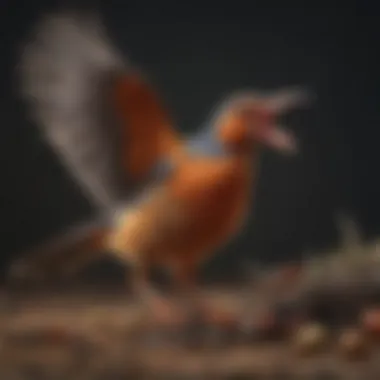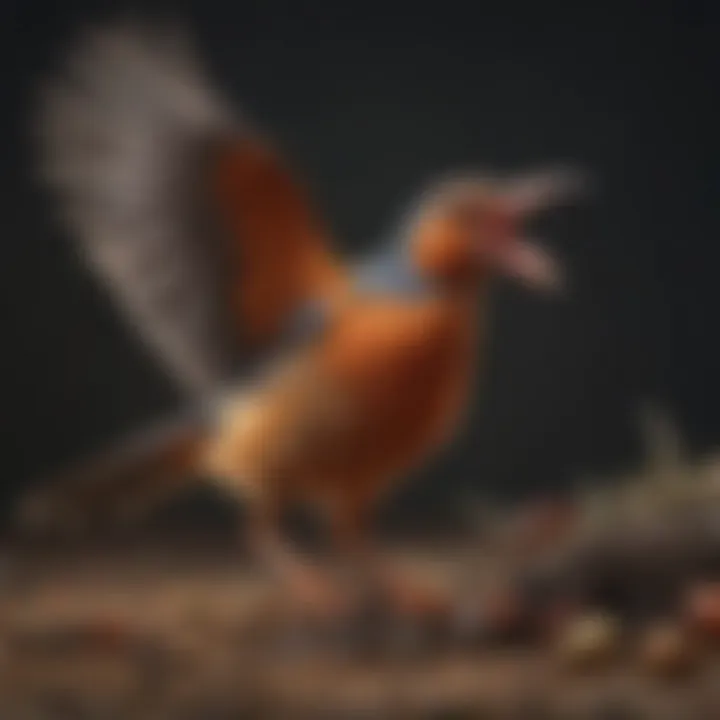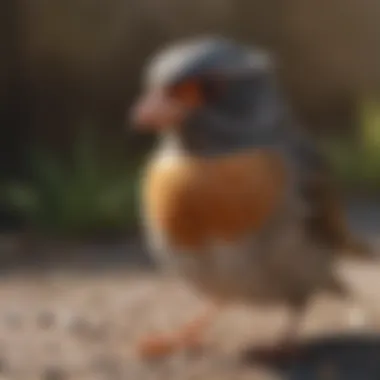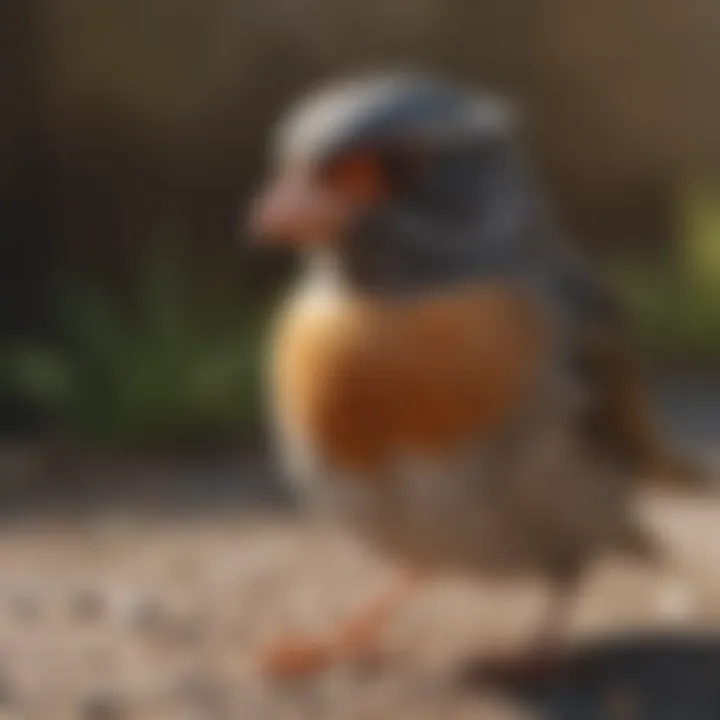Understanding the Causes and Effects of Bird Shock


Intro
The phenomenon of birds in shock merits a thorough analysis due to its implications on avian health and behavior. Many people, including homeowners, find themselves perplexed when they encounter birds exhibiting unusual behavior or distressed states. Understanding the causes and consequences of shock in birds can lead to better interactions with these creatures and can aid in their conservation. This article will delve into various aspects of shock in birds, providing valuable insights for individuals interested in ornithology, students in related fields, or simply homeowners keen on understanding wildlife in their vicinity.
Key Points Discussed
- Definitions and Triggers: We will identify what constitutes shock in birds and explore common triggers involved.
- Biological and Ecological Factors: Understanding how biological makeup and ecological factors contribute to shock responses in birds.
- Behavioral Responses: Examination of how shock affects avian behavior and what this means for their survival.
- Impacts on Health: Insights into the health implications for birds that experience shock.
By the end, readers will have a comprehensive understanding of the phenomenon, enriched by a blend of scientific facts and practical advice.
Prelims to Avian Shock
The topic of avian shock is crucial because it deals with how birds respond to extreme stress. This condition informs us about their health, behavior, and interactions with their environment. Understanding shock responses can benefit various stakeholders, including wildlife managers and everyday homeowners. This section will provide an introductory overview of shock in birds, its definition, and the significance of rigorous study in this area.
Defining Shock in Birds
Shock in birds refers to a state of acute physiological and behavioral responses to overwhelming stressors. These can include environmental hazards, predator encounters, or extreme changes in their habitat. Signals of shock might include unusual flight patterns, lethargy, or vocalizations that are out of character. It is essential to understand that shock is not just a momentary state; it can lead to significant challenges in survival if the birds do not recover quickly.
The definition can be broadened to encompass both physical and emotional responses. Birds might exhibit signs of detachment or aggression toward other birds. The physiological aspects typically involve a heightened state of alertness followed by a potential collapse if stress is prolonged. This mixture of reactions is vital, as it helps us understand how avian species cope with threats in their surroundings.
Importance of Studying Avian Shock
Studying avian shock is important for several key reasons:
- Wildlife Management: Knowledge of bird shock responses can help in creating better management practices in the wild. Understanding what triggers shock can lead to better habitat preservation strategies.
- Conservation Efforts: Birds are indicators of ecological health. By monitoring their shock responses, we can assess the impact of environmental changes and potentially inform conservation efforts.
- Educational Insights: For educators and students in ornithology, studying these responses provides insights into behavioral ecology and animal behavior. It opens a pathway for critical thinking about animal welfare and environmental interactions.
- Homeowner Awareness: Homeowners who understand avian shock can contribute to creating a bird-friendly environment. Recognizing signs of shock in local birds can enhance community efforts to protect wildlife.
"Understanding shock in birds allows us to become better stewards of their environments."
Overall, the study of avian shock provides invaluable insights not just into the lives of birds, but also into the health of the ecosystems they inhabit.
Biological Mechanism of Shock Responses
The biological mechanisms underlying shock responses in birds represent a critical aspect of understanding their overall well-being and behavior. Recognizing how birds physiologically and neurologically react to shocking stimuli not only sheds light on their resilience but also informs conservation strategies.
Birds have a unique set of physiological responses that kick in during episodes of shock. These responses play a vital role in saving energy and enhancing survival prospects during and after distressing events. Understanding these mechanisms allows researchers and enthusiasts alike to appreciate the complexities of avian biology, ultimately facilitating better management approaches in both natural and controlled environments.
The Physiological Response to Shock
When a bird encounters a shocking event, several physiological changes occur almost instantaneously. The initial response often includes an increase in stress hormones such as cortisol. This hormone triggers a cascade of reactions within the body. Here are key elements of the physiological response:


- Increased Heart Rate: The heart begins to pump faster to supply more oxygen to vital organs.
- Rapid Breathing: Breathing rate also increases, allowing for more efficient oxygen exchange.
- Metabolic Shift: Energy is diverted from non-essential functions to those that are critical for immediate survival.
These responses are important because they help the bird either fight the stressor or flee from it. This is known as the flight-or-fight response. However, prolonged exposure to stressors can interfere with normal physiological functions, leading to health problems.
Neurological Impacts on Behavior
The neurological impacts of shock also play a significant role in shaping avian behavior. When birds enter a state of shock, their brain undergoes alterations in processing information. Key effects include:
- Altered Perception: Birds may become more sensitive to environmental stimuli, interpreting common sounds or movements as threats.
- Aggression or Withdrawal: Different birds may respond to shock behaviorally. Some might exhibit aggression, while others might isolate themselves.
- Disruption of Social Hierarchies: Shock can disrupt relationships within flocks. Dominance structures may be challenged as individual birds react differently to stress.
Understanding the neurological impacts on behavior can help bird enthusiasts better interpret and respond to the complexities of avian interactions during stressful times.
These changes can lead to long-term effects on their ability to interact with their environment successfully. Knowing how these mechanisms work aids in the development of strategies to create a better habitat for birds.
By studying the biological mechanisms of shock responses, we deepen our understanding of the resilience of birds in their natural environments. This knowledge is essential for promoting a healthy coexistence between birds and the human-inhabited areas they share.
Common Triggers of Bird Shock
Understanding the common triggers of bird shock provides crucial insights into avian behavior, allowing for better management and mitigation strategies. By recognizing what induces shock in birds, homeowners and ornithology enthusiasts can take informed actions to protect bird populations in their vicinity. The triggers we explore can shed light on how birds respond to their environment, helping us understand a broader ecological picture.
Environmental Disturbances
Environmental disturbances represent a significant category of triggers that can lead to shock in birds. Such disturbances can arise from both natural phenomena and human-related activities. Recognizing these triggers is pivotal in mitigating their impact.
Natural Disasters
Natural disasters, such as hurricanes, earthquakes, and wildfires, have a profound effect on bird populations. These events can cause widespread habitat destruction, altering the landscape that birds rely on for food and shelter. The suddenness and intensity of natural disasters leave birds disoriented and vulnerable.
The key characteristic of natural disasters is their unpredictability. This unpredictability makes them a relevant choice for our discussion. For example, during a hurricane, many bird species struggle to find suitable shelter when their nesting sites are destroyed. This creates increased stress and can lead to fatal outcomes for many individuals.
The unique feature of natural disasters is that they not only impact the immediate area but can also have long-term ecological consequences. Habitats may take years, or even decades, to recover fully. Consequently, bird populations may experience declines in survivorship and reproductive success. In exploring this topic, we can better understand how to protect vulnerable species during such extreme events.
Human Activities
Human activities constitute another critical aspect of environmental disturbances. Urbanizing landscapes, deforestation, and pollution are all factors that can contribute to bird shock. With increasing urbanization, natural habitats are fragmented, disrupting the migratory patterns of many bird species.
The key characteristic of human activities is their often preventable nature. Societal choices heavily influence these outcomes. For example, improper waste disposal can attract predators, posing threats to smaller bird species. Understanding these dynamics helps us identify correctable behaviors that can lessen the impact of shock triggers.
Unique to human activities is their capacity to influence a larger scale of environmental change. Pollution can affect food sources, and habitat destruction can lead to the loss of essential breeding grounds. Birds inhabiting affected areas may face increased stress, leading to a higher likelihood of experiencing shock. Recognizing these aspects emphasizes the need for sustainable practices in our interactions with nature.
Predator Encounters


Predator encounters are significant triggers for avian shock. Birds have evolved various strategies to minimize confrontation with predators. However, the presence of a predator can produce an immediate shock response. This reaction can manifest as sudden flight, erratic movement, or freezing in place. These behaviors, though instinctive, can lead to vulnerability, especially when birds are caught off guard in their feeding or nesting activities.
Captivity and Rehabilitation Scenarios
Captivity and rehabilitation scenarios also serve as triggers for shock in birds. Birds taken out of their natural environments, such as after injuries or abandonment, may experience distress due to the unfamiliar surroundings. The shift from freedom to confinement can induce significant anxiety, which may lead to physiological shock responses. Understanding these scenarios is crucial for wildlife rehabilitators aiming to foster recovery and reduce stress for the birds in their care.
Behavioral Indicators of Shock in Birds
Understanding the behavioral indicators of shock in birds is crucial for both professionals in ornithology and homeowners who may encounter these situations. Shock responses can provide insights into the health and well-being of avian species. Recognizing these behaviors enables timely interventions and the mitigation of stressors that could lead to further complications. Behavioral changes are often the first sign of distress, making their identification vital for conservation efforts and domestic environments alike.
Physical Manifestations
Flight Patterns
Flight patterns can reveal a lot about a bird's state of shock. In a normal situation, birds exhibit controlled and purposeful flight. However, during shock, their flight patterns may become erratic and uncoordinated. This specific aspect indicates a lack of control and heightened anxiety in the bird. A startled bird might engage in frantic flapping, which can result in collisions or injuries.
The key characteristic of disrupted flight is its suddenness. A bird that typically glides gracefully may suddenly appear disorientated. This erratic behavior is beneficial for this article as it highlights the urgent need for observation. Observing flight patterns can help homeowners understand when a bird is in distress or danger.
One unique feature of changed flight patterns is that they can occur quickly after a trigger, such as loud noises or predator presence. Awareness of these signs has advantages in urban settings, where birds often face sudden threats. However, it can also present disadvantages if the observers are not equipped to assist or create a safer environment for the affected birds.
Posture and Vocalizations
Posture and vocalizations are also direct indicators of shock. Birds usually maintain an upright posture, signaling health and alertness. In contrast, a shocked bird may exhibit a hunched or crouched posture. This behavior signifies fear or distress, suggesting it is attempting to minimize its visibility to potential threats.
The key characteristic of posture changes is their subtlety. Homeowners may notice birds perched unusually low or completely still. This aspect is popular in the context of this article, as it educates homeowners on recognizing stressed birds in their vicinity. Intentional observation can lead to timely assistance for these creatures.
Vocalizations during shock can also change significantly. Birds might produce distress calls or fail to vocalize entirely, indicating that something is wrong. A key advantage in recognizing these changes is that they can alert people to the bird's condition. However, the disadvantage lies in the possibility of misinterpretation, as not all vocalizations signify shock. Awareness and knowledge about typical bird sounds can mitigate this confusion.
Changes in Social Interactions
Changes in social interactions often accompany shock responses in birds. Birds typically engage in social behaviors like preening or feeding together. When under stress, these interactions may decrease. A shocked bird often isolates itself from its flock. This behavior underscores the severity of its condition. Understanding these changes is essential for anyone interested in promoting avian well-being. Recognizing a bird's withdrawal or aggression can guide appropriate responses in residential areas, especially among pet owners or bird enthusiasts.
Avian social structures are key to their survival. Disturbances in these interactions can have longer-term impacts on their health and reproduction.
Recognizing the signs of shock early can lead to better outcomes for affected birds.
Ecological Consequences of Bird Shock
The phenomenon of bird shock is not merely an issue for the individual bird. It extends its reach into the broader ecological framework. Understanding the ecological consequences of bird shock is essential. This segment aims to emphasize how shock impacts avian populations, their interactions with ecosystems, and ultimately, biodiversity.
One primary concern regarding bird shock is its impact on survival rates. When birds experience shock, their ability to forage, escape predators, or navigate is compromised. In severe instances, this can lead to fatalities. These survival rates are crucial for maintaining stable bird populations. Such fluctuations can also strain the food webs they inhabit. As birds play significant roles in seed dispersal, pollination, and pest control, their diminished numbers can ripple through the ecosystem, affecting plant health and insect populations.


In addition, the effects of reproductive success are another significant element of the ecological consequences of bird shock. When birds are under stress, they may abandon nests or fail to care for their young adequately. This abandonment leads to a decline in the next generation, creating a domino effect on population stability. Studies show that even minor amounts of stress can impact hormone levels, which in turn affect reproductive behaviors. Moreover, lower reproductive success may force birds to compete more fiercely for resources, placing additional strains on their populations.
To summarize, the ecological consequences of bird shock present serious implications for avian species and the overall health of ecosystems. Both mortality rates and reproductive outcomes result in changes that can significantly shape the natural world. It's vital for homeowners to recognize these effects, as the wellbeing of birds intertwines closely with the environment that surrounds them.
"Birds are indicators of environmental health; their distress signals can inform us about ecosystem changes."
Promoting awareness and understanding such ramifications can lead to more conscientious efforts in habitat conservation and wildlife management.
Mitigation Strategies for Avian Shock
Mitigation strategies for avian shock are essential not only for the well-being of birds but also for promoting a healthier ecosystem. With many birds facing various stressors, understanding how to alleviate these triggers becomes paramount. By implementing effective strategies, we can reduce the impact of shock responses in birds and help them recover more effectively.
Creating Safe Habitats
Creating safe habitats for birds involves several critical aspects. A habitat that caters to the needs of different bird species can significantly lower stress levels. Here are some effective elements to consider when designing bird-friendly spaces:
- Native Vegetation: Planting native species supports local wildlife and provides necessary shelter and food sources.
- Water Sources: Fresh, clean water should be accessible for drinking and bathing. Bird baths or ponds can be beneficial.
- Avoiding Pollution: Minimize chemical use, such as pesticides and herbicides. These substances can harm birds directly and degrade their habitat.
- Safe Nesting Areas: Ensure that there are safe spaces for birds to nest without interference or predation.
Providing these conditions encourages birds to thrive, reducing the likelihood of shock-inducing events related to habitat loss or environmental stressors. A secure habitat fosters a sense of safety, which is crucial during stressful situations. It is also important to assess urban spaces to enhance their suitability for birds, as even small changes can have lasting effects.
Educating the Public
Public education plays a vital role in mitigating avian shock. By raising awareness, homeowners can take informed actions to support local bird populations. Here’s how education can make a difference:
- Workshops and Programs: Holding community workshops about bird behavior and conservation can enlighten residents. Discussions can include recognizing signs of distress in birds.
- Behavioral Guidelines: Teaching people how to respond if they encounter a bird in shock is essential. Simple measures, like leaving the bird alone or contacting a wildlife rehabilitator, can save lives.
- Resource Distribution: Sharing handouts or creating online resources that detail local bird species, their needs, and best practices for their care can empower communities. Links to resources such as Wikipedia and Britannica provide valuable information to the public.
- Collaborative Efforts: Encouraging local partnerships with schools, environmental organizations, and wildlife experts can promote shared goals for bird preservation.
By fostering a community that values and understands the ecological significance of birds, we can greatly improve their chances against shock responses. Knowledge encourages proactive measures that directly benefit avian health and habitats.
Educating the public is a crucial aspect of support for birds, creating a more resilient ecosystem for all.
Overall, the integration of safe habitats and public education forms a strong foundation in addressing avian shock. Both aspects warrant attention and action to ensure birds have a better chance at thriving in their environments.
Ending
The significance of understanding shock in birds cannot be underestimated. This article reinforces critical aspects of avian shock, including its biological, ecological, and behavioral dimensions.
Summary of Key Points
- Defining Shock: Shock manifests as a vital response to extreme stressors, both environmental and social. Knowledge of avian shock allows for proper identification and management.
- Triggers: Understanding the triggers, such as natural disasters, predator encounters, and captivity, enables better conservation strategies and habitat management for birds.
- Behavioral Indicators: Recognizing physical and social changes in birds during shock assists homeowners in responding appropriately to distressed avian visitors.
- Ecological Impact: The consequences of shock extend beyond individual birds. They affect populations, survival rates, and broader ecological dynamics.
- Mitigation Strategies: Implementing strategies, such as safe habitats and public education, is vital for reducing instances of shock and promoting healthier avian communities.
Future Research Directions
Future studies could delve deeper into several areas to enhance our understanding of avian shock:
- Longitudinal Analysis: Tracking bird populations over time to identify long-term behavioral changes and survival rates post-shock events.
- Impact of Urbanization: Exploring how increasing urban environments affect bird stress responses and the prevalence of shock.
- Species-Specific Responses: Investigating how different bird species react to shock and whether certain traits make them more vulnerable.
- Community-Based Approaches: Engaging homeowners and local communities in citizen science projects focused on observing and reporting avian behaviors during distress.
Research should also aim to inform practical measures that can further assist birds in coping with their environments. By better understanding the phenomenon of shock in birds, there can be broader implications not only for wildlife management but also for fostering a more harmonious coexistence with nature.







